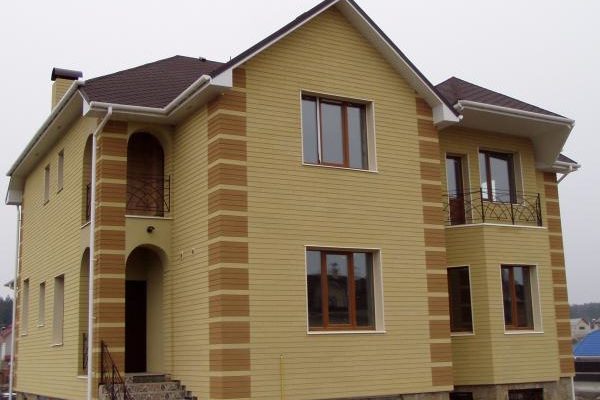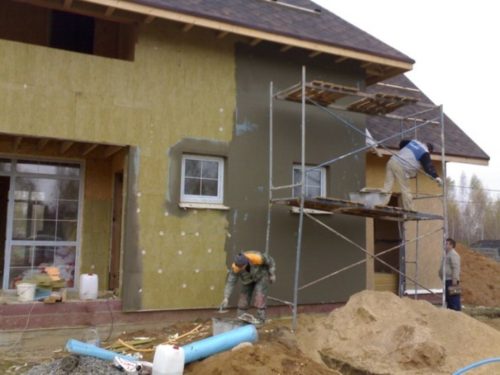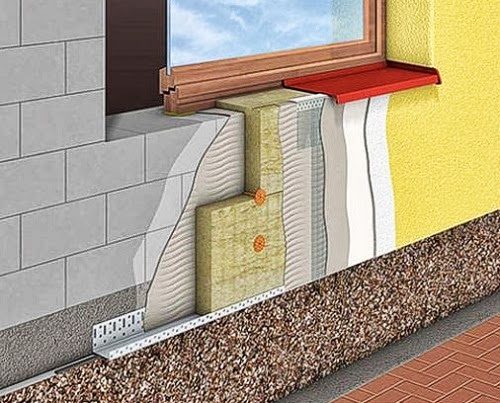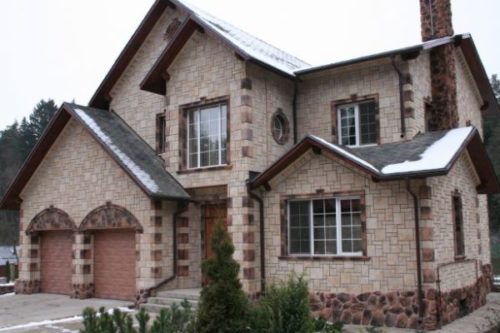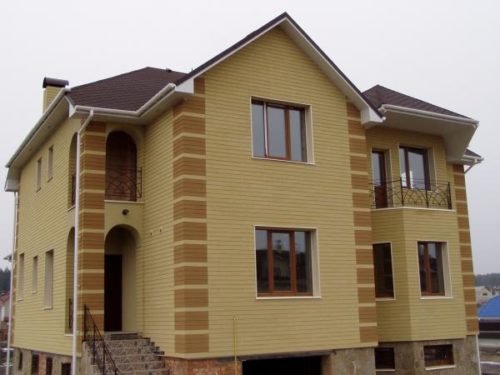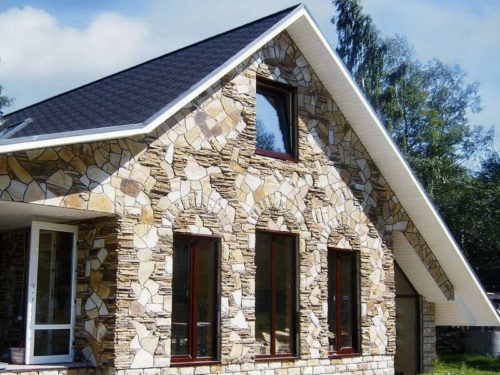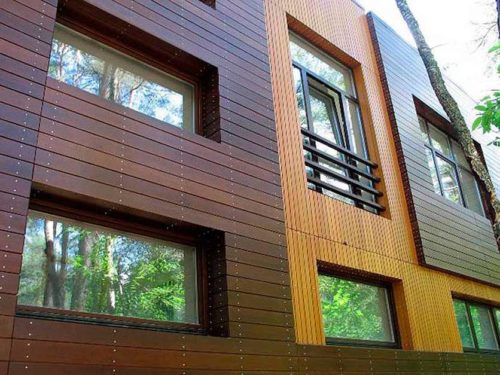The facade of the building is its business card. As far as there is a modern and expensive repair of the interior, the inephious exterior will immediately spoil the whole picture. In modern construction business there are many options for finishing the facade of a private house. Their choice depends on several factors. Firstly, these are the climatic features of the region in which the house was built, for example, in southern Europe make a warmed ventilated facade makes no sense. Secondly, the choice of material should be based on the harmony of the appearance of the house with the outside world. The house standing in the middle of the stone jungle of the urbanized megalopolis with finishing from natural lining, will look somewhat ridiculous. Well, the last factor that determines the choice of the type of facade is its cost. The most simple and cheap are wet facades, but the ventilated structures are quite expensive.
Content
Options for finishing the facade of the building
In addition to the aesthetic component, the facade of the building performs several more functions:
- Heat insulation.
- Noise insulation.
- Waterproofing walls.
On how to choose the option of the facade for a private house and make it with your own hands, let's tell later. The increase in the nomenclature of building materials and the application of new external finishing technologies makes it possible to choose in this difficult question. Now you can easily choose the most suitable option in all parameters, which perfectly fit into the project of the house. All types of finishes of the facade can be divided into two main groups:
- Wet facades. They received such a name due to the fact that wet mixes are used for installation (plaster). Such facade is cheaper than materials, however, its device requires more time. Often, under such a facade, an insulation of solid materials (polystyrene foam, polymer concrete, etc.) is installed. Decorative stone, brick and tile can also be attributed to wet facing.
- Ventilated facades. It is called so due to the presence of ventilated channels (gap between the facade and insulation), due to the circulation of air along which the insulation is not exposed to moisture. Installation of the ventilated facade provides for the installation of metal structures from steel profiles (facade crates) to which the facing material will be attached. Unlike wet facades, ventilated have a large frequency period. If the plaster should be renewed at least once every five years, the facade of plastic, professional flooring or composite panels gently only periodically wash away from dirt using high pressure washes. Such a design may simultane without repairing not one dozen years old and not lose its appearance.
Outdoor Finishing Facade Building - Plaster
Description and characteristics of plaster for finishing facades
This type of decoration of buildings is one of the most ancient. The cladding of clay buildings with their subsequent color was known at the dawn of civilization. Plaster has, both a number of advantages and a large number of flaws.
From the strengths of the plaster you can allocate, first of all, the cost of materials. In comparison with decorative stone or brick, there are mixes for plaster cheaper. Also, plastered walls can be painted in any color, thereby changing the appearance of the house. Of the disadvantages of plaster, you can allocate the need for additional preparation of walls before starting work, as well as high laboriousness of repair. It is also worth noting the need for continuous surface care, as the plaster is not moisture-resistant material and when the upper layer is damaged, it may turn.
Currently, the following types of plasters are used for the external finishing of facades:
- Mineral plaster. This is the most common type of plaster, which has proven itself for a long time. It consists of cement, sand and special additives (dyes and modifiers) that make it stronger. This type of plaster has good vapor permeability, so under it it is necessary to install the insulation. With proper operation, mineral plaster can stand up to two decades before cracking. One of the most popular recent techniques of plaster is a croroede. The surface of the facing resembles a tree eaten by the core. The facade looks very attractive, but requires additional care, as dust can be clogged in the plaster slots.
- Acrylic plaster. A relatively new kind of facade facing. Its strength is elasticity, therefore the probability of cracking on it is much lower than that of mineral plaster. The disadvantages of such a finish are two: a higher price in comparison with mineral, as well as a high degree of dustproalth. The latter makes undesirable to use acrylic plaster for finishing facades of buildings in the road. Over time, she can simply lose its color.
- Silicone plaster. This is the most modern type of finish. She absorbed almost all the strengths of this finish. Silicone plaster elastic, preserved in advanced form up to 25 years, does not absorb dust, salt and moisture. However, it is worth such a coating quite expensive.
Instructions for phased finish facade plaster
Execution of works on the plaster of the building:
- The first step is to clean the surface of the walls of the old plaster, if any.
- Then identify the problem areas and repaired them. Next, the surface is primed.
- After that, lighthouses are exhibited on the surface of the walls (metal strips for smooth application of plaster).
- The solution of plaster is characterized in such a way that it is average yield (thick sour cream).
- The solution is attacked between beacons and stretched with the help of the rule. You can then apply paint for the facade.
Decorative stone for finishing the facade of the building
Thanks to the decorative stone, a very beautiful facade of a private house can be made. This type of finish never loses relevance, so even across decades the house will look modern and beautiful. The stone is cold material, so the layer of insulation should be placed under it. A large number of forms and colors of both natural and artificial stone I give the opportunity to make a unique facade in a medieval style.
Facing facade with decorative panels
Facing facade with decorative panels is more economically appropriate, even despite their cost. Low laboriousness, optional surface preparation, high service life levels material cost. Distinguish panels by material from which they are made:
- Metal panels. Made from galvanized steel, aluminum or composite material. Covered the metal base with polymer material, which gives it a certain color and protection against corrosion. Basically, such panels are used for mounting ventilated facades, and even very old and unsightly walls can be "hide" under it, giving the building a completely new look. The disadvantage of such panels is their high thermal conductivity. That is why they are mounted only on a layer of insulation, as a rule, on mineral wool.
- Facade of the facade siding. Vinyl siding is considered one of the most popular materials for finishing. It is very easily processed, has good thermal insulation and moisture resistance, and it is relatively inexpensive. Also, one of the main advantages of Vinyl is its fire safety. When installing vinyl siding, you need to take into account the fact that it is expanding when heated, so it is necessary to leave technological gaps. Otherwise, summer siding may be a story. One of the main shortcomings of vinyl siding is its fragility at low temperatures, so installing it in winter is undesirable.
- Fiber Plates. This material was coming relatively recently. They consist of a mixture of cement and cellulose fibers. Thanks to this, the slabs are obtained very durable, they are not afraid of fire, moisture and temperature drops, and also differ in excellent indicators of heat maintenance. Often, such panels decorated with tiles, so after their installation does not need to paint the facade.
- Sip panels. They are often called a sandwich panel. They obtained such a name because they consist of two sheets of steel or other material, and a layer of insulation between them. Thanks to this panels have low vapor permeability and a long service life.
Facade finish with decorative brick
Decorative brick is one of the most popular materials for the exterior decoration of the building. It differs from the usual brick smaller dimensions, weight and large variety of colors, which is achieved by the use of various dyes in its production. Stacking decorative bricks are carried out on top of the main walls. The only drawback of such a finish is that it should provide a certain foundation width. If the base is very narrow, the installation of facing brick will be difficult.
Facade Outdoor Facade
The front board, or as it is also called (Planken), differs from the usual lining with special processing. The advantages of the outer finish of the facade tree are obvious. It is environmentally friendly, allows the walls to breathe, well insulates the house, it is distinguished by natural natural warmth and beautiful appearance. However, with a long-term exposure of moisture, it can be combined and leading, from which the type of finishing becomes not quite pleasant. In addition, wood is subject to a detrimental effect of pests. Specially processed panels (plaquen) are not afraid of moisture, as they are made mainly from the larch, which contains in itself a large number of resins. Unlike the lining, the plaquen is not mounted in the castle, but with a gap, which allows such a "breathing" the facade and makes it possible to replace the boards that have come into disrepair without disassembled the entire facade. This material is carefully processed and polished from all sides, does not have sharp corners and chamfers. For better protection, each board is impregnated with anti-grapple impregnation and is covered with several layers of varnish. From such a facade in the house will always be comfortable and cozy.

